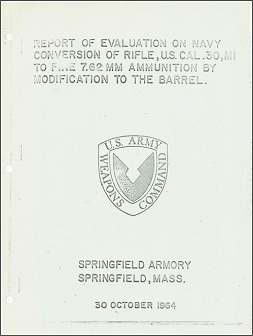Back in the 1960s, the US Navy decided to rechamber a bunch of its M1 Garand rifles to 7.62 NATO. The proper way to do this would have been to simply put new 7.62 barrels into the rifles – but the Navy wanted a cheaper route. So instead, they decided to make chamber inserts that could allow the use of 7.62 NATO in existing .30-06 barrels. The notion was that the chamber insert could be fixed in place simply by slipping it into the chamber of an M1 Garand and firing two rounds of M80 7.62 ball ammo to seat it in place. No threading, no adhesives – just a pressure fit. Well, Springfield Arsenal took several of these rifles and tested out the conversion.
We have a copy of the original test report, dated October 30, 1964, which you can download right here (complete with dimensioned drawings of the chambers and adapters):

Well, the test results were less than spectacular. Springfield determined that the chamber adapter dimensions didn’t quite fit either the .30-06 chambers OR the 7.62×51 cartridges. So the procedure to properly install one was to first clean the chamber, then use a special reamer to open it up slightly. Then clean the chamber again, and load the chamber adapter and a round of 7.62. This could require a couple attempts to fully seat, since the adapters were 0.008 too tight at the neck to fit the 7.62 cartridges. Once the round and adapter were chambered and the bolt fully closed, the round would be fired, and then a second round also fired. This would fully seat the chamber adapter, after which a second special reamer was used to open up the adapter to the correct dimensions.
In addition, the gas port on the barrel needed to be enlarged. The M80 7.62 cartridge developed greater velocity than M2 .30-06, but had less pressure at the gas port, hence the larger port required. Both .0995 and .1065 inch gas ports were tested, with 0.1065 being found best for proper functioning of the rifle. However, when grenade launching was tested the 7.62 conversions were found to have dangerously high bolt opening velocity, and deemed unsafe.
Folks with commercially-made .308/7.62 Garand rifles should take note of this, as it applies to these rifles as well. It may be tempting to get some blanks and dummy grenades to launch for fun (the thought has certainly occurred to me) – but don’t! The M1 gas system when opened up for cycling with .308 produces too much pressure in this situation for safe operating.
Anyway, back to the Navy conversions. The testing evaluation found a slew of objections to the chamber conversions. In addition to the multiple reaming steps required for proper installation, the adapters were still liable to come out unexpectedly. Use of a broken shell extractor could also loosen an adapter. They left about half an inch of freebore for the 7.62 bullet to travel before engaging rifling, which hindered accuracy and increased throat erosion. They tended to have out of spec headspace as a result of the conversion. Needless to say, the test conclusions suggested just replacing the whole barrel to convert an M1 to 7.62 NATO. The Navy eventually chose this route, but many of the adapters were reportedly sold as surplus, and may be encountered today.



I thought the grenade launcher on the M1 was designed to bypass the gas system by opening up the popet valve on the front of the gas cylinder when firing a grenade (at least the one sample I own does). I am surprised to read that the bolt velocities were so high. Does any one know which of the launchers were used in the testing. It would seem to me that this problem could easily be fixed by modifying the size of the popet valve opening or making the launcher open the valve earlier.
I had one that was an import that came from the Paraguay Navy. I put quite a few rounds through it with no problems. From the looks of it when I got it, it defently didn’t have much rack time.
Is there an easy way to identify which one a person might have like special markings?
Have one such naval conversion with a 1953 original barrel shortened to use the 308 cartridge. There is a nylon buffer in the cartide well, the barrel is stamped 308 on the right side of the barrel. Have owned it for a lot of years and have never fired it. It is not for sale but am attempting to find it’s value. The receiver is an International Harvester. Has been used and would consider it better than 60%. Has a Harvester stock and cartouches as well.
Just leave it 30-06. Reload if you can’t find surplus ammo, don’t use modern ammo not intended for the M1.